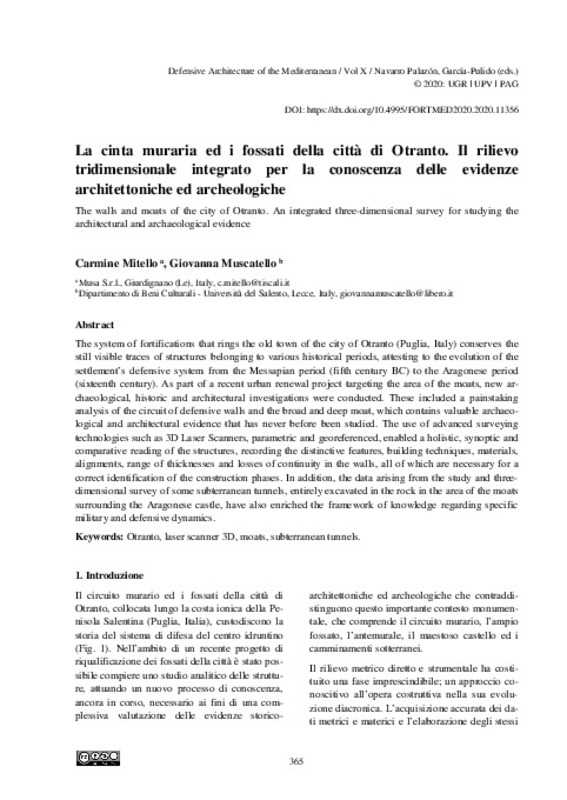JavaScript is disabled for your browser. Some features of this site may not work without it.
Buscar en RiuNet
Listar
Mi cuenta
Estadísticas
Ayuda RiuNet
Admin. UPV
La cinta muraria ed i fossati della città di Otranto. Il rilievo tridimensionale integrato per la conoscenza delle evidenze architettoniche ed archeologiche
Mostrar el registro sencillo del ítem
Ficheros en el ítem
| dc.contributor.author | Mitello, Carmine
|
es_ES |
| dc.contributor.author | Muscatello, Giovanna
|
es_ES |
| dc.coverage.spatial | east=18.4911678; north=40.1438978; name=Via Antonio Primaldo, 3, 73028 Otranto LE, Itàlia | es_ES |
| dc.date.accessioned | 2020-07-03T10:53:41Z | |
| dc.date.available | 2020-07-03T10:53:41Z | |
| dc.date.issued | 2020-05-15 | |
| dc.identifier.isbn | 9788490488560 | |
| dc.identifier.uri | http://hdl.handle.net/10251/147371 | |
| dc.description.abstract | [EN] The system of fortifications that rings the old town of the city of Otranto (Puglia, Italy) conserves the still visible traces of structures belonging to various historical periods, attesting to the evolution of the settlement’s defensive system from the Messapian period (fifth century BC) to the Aragonese period (sixteenth century). As part of a recent urban renewal project targeting the area of the moats, new archaeological, historic and architectural investigations were conducted. These included a painstaking analysis of the circuit of defensive walls and the broad and deep moat, which contains valuable archaeological and architectural evidence that has never before been studied. The use of advanced surveying technologies such as 3D Laser Scanners, parametric and georeferenced, enabled a holistic, synoptic and comparative reading of the structures, recording the distinctive features, building techniques, materials, alignments, range of thicknesses and losses of continuity in the walls, all of which are necessary for a correct identification of the construction phases. In addition, the data arising from the study and threedimensional survey of some subterranean tunnels, entirely excavated in the rock in the area of the moats surrounding the Aragonese castle, have also enriched the framework of knowledge regarding specific military and defensive dynamics. | es_ES |
| dc.language | Italiano | es_ES |
| dc.publisher | Editorial Universitat Politècnica de València | es_ES |
| dc.rights | Reconocimiento - No comercial - Sin obra derivada (by-nc-nd) | es_ES |
| dc.subject | Fortifications | es_ES |
| dc.subject | Mediterranean | es_ES |
| dc.subject | Modern age | es_ES |
| dc.subject | Built Heritage | es_ES |
| dc.subject | Otranto | es_ES |
| dc.subject | Laser scanner 3D | es_ES |
| dc.subject | Moats | es_ES |
| dc.subject | Subterranean Tunnels | es_ES |
| dc.title | La cinta muraria ed i fossati della città di Otranto. Il rilievo tridimensionale integrato per la conoscenza delle evidenze architettoniche ed archeologiche | es_ES |
| dc.title.alternative | The walls and moats of the city of Otranto. An integrated three-dimensional survey for studying the architectural and archaeological evidence | es_ES |
| dc.type | Capítulo de libro | es_ES |
| dc.type | Comunicación en congreso | es_ES |
| dc.identifier.doi | 10.4995/FORTMED2020.2020.11356 | |
| dc.rights.accessRights | Abierto | es_ES |
| dc.description.bibliographicCitation | Mitello, C.; Muscatello, G. (2020). La cinta muraria ed i fossati della città di Otranto. Il rilievo tridimensionale integrato per la conoscenza delle evidenze architettoniche ed archeologiche. Editorial Universitat Politècnica de València. 365-372. https://doi.org/10.4995/FORTMED2020.2020.11356 | es_ES |
| dc.description.accrualMethod | OCS | es_ES |
| dc.relation.conferencename | FORTMED2020 - Defensive Architecture of the Mediterranean | es_ES |
| dc.relation.conferencedate | Octubre 01-03,2020 | es_ES |
| dc.relation.conferenceplace | Granada, Spain | es_ES |
| dc.relation.publisherversion | http://ocs.editorial.upv.es/index.php/FORTMED/FORTMED2020/paper/view/11356 | es_ES |
| dc.description.upvformatpinicio | 365 | es_ES |
| dc.description.upvformatpfin | 372 | es_ES |
| dc.type.version | info:eu-repo/semantics/publishedVersion | es_ES |
| dc.relation.pasarela | OCS\11356 | es_ES |








